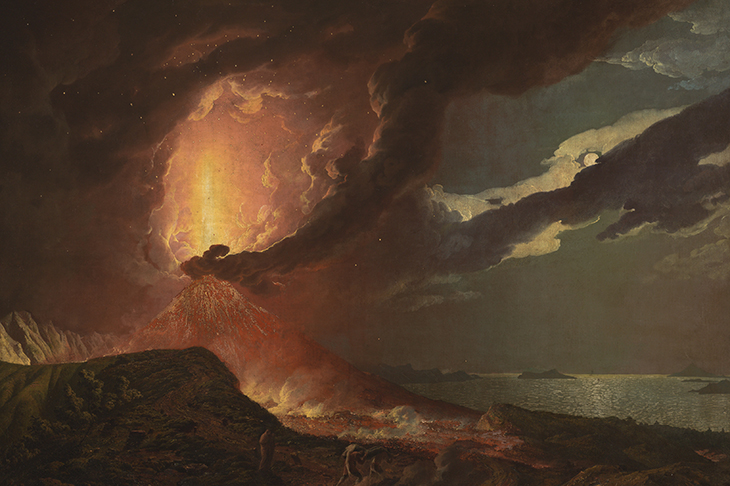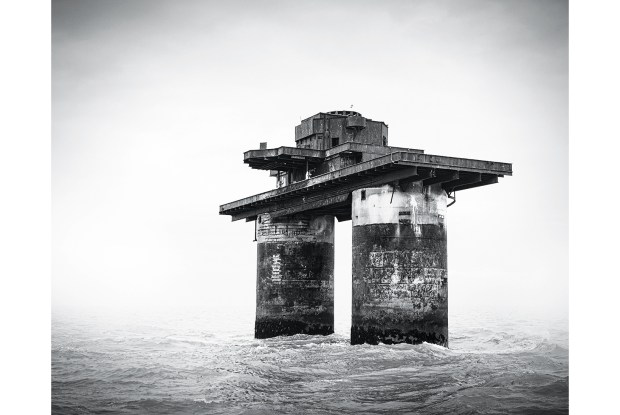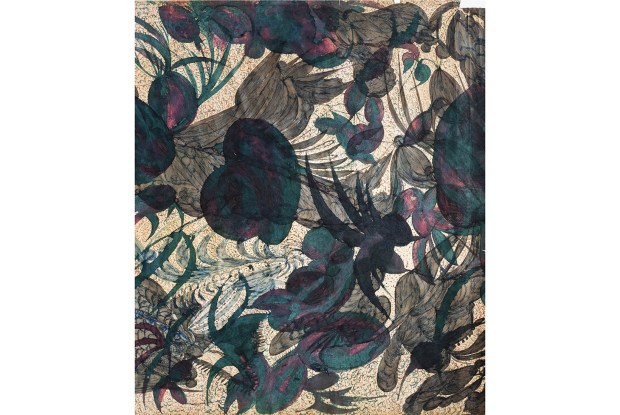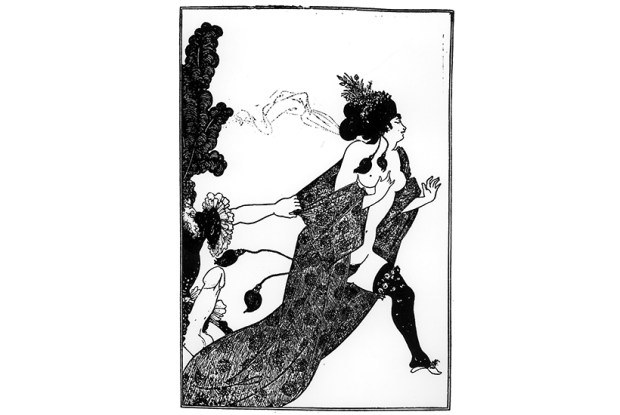‘Playing God is indeed playing with fire,’ observed Ronald Dworkin. ‘But that is what we mortals have done since Prometheus, the patron saint of dangerous discoveries.’
There’s no Prometheus in the RWA’s new exhibition Fire: Flashes to Ashes in British Art 1692–2019, but there are plenty of flames, some dangerous, some not. The third in the Bristol gallery’s trilogy of shows on elemental themes, following The Power of the Sea (2014) and Air (2017), Fire features the most dramatic of the four elements, and the most fun to paint. Artists love playing with fire. It’s a subject that has held audiences in thrall since medieval worshippers were kept on the edge of their pews by ‘Doom’ paintings warning of the hellfire awaiting them if they fell asleep during the sermon.
Sadly most of those went up in smoke during the Reformation, and British audiences had to wait for the Dutch tenebrist Godfried Schalcken to cross the Channel in the 1690s and relight our extinguished fire-painting tradition with his ‘Boy Blowing on a Firebrand to Light a Candle’ (c.1692–98), the picture that opens this show. In the 18th century Joseph Wright of Derby took up Schalcken’s torch and applied it first to candlelit interiors, then to forges and furnaces and eventually to volcanoes in more than 30 paintings of Vesuvius erupting (a sight he never witnessed), one of which is a highlight of the exhibition.
Wright’s volcanoes sold like hot cakes to an 18th-century audience hungry for a dose of the ‘delightful horror’ identified by Edmund Burke as a key ingredient of the sublime. If the fires of hell were out, then the pillars of flame, columns of smoke and showers of sparks thrown up by a forge of Vulcan going hammer and tongs were the next best thing. In the following century John Martin took the horror to gothic extremes in flaming fantasy landscapes like ‘Sadak and the Waters of Oblivion’ (1812), also featured in the show. With the unveiling of this picture at the Royal Academy, reported one critic, Martin ‘blazed a meteor in the world of art’.
But the appeal of fire to artists and audiences could be subtler. Painting fire was a test of a painter’s command of chiaroscuro, and chiaroscuro allied to a hot palette could also convey the comforts of hearth and home. Ralph Hedley reminds us that humanity has much to thank Prometheus for in his painting ‘Meal Time’ (1895) picturing a Geordie housewife standing over a hot stove while her husband enjoys a fireside pipe; William Banks Fortescue, in ‘By Hammer and Hand, All Arts Doth Stand’ (undated), highlights the benefits of fire to industry with a glimpse into the sweaty interior of a busy blacksmith’s. The downside of Prometheus’s gift is brought home by J.M.W. Turner in a vivid watercolour sketch of the armaments store at the Tower of London going up in flames in 1841, the foreground smoke apparently smudged on with a sooty finger.
The show is surprisingly short on military shock and awe, but makes up for in fireworks what it lacks in bombs. Eric Ravilious lights up the London sky on ‘November 5th’ (1933) with a surreal tracery of feux d’artifice shaped like giant flowers. In the back gardens of his Hammersmith terrace neighbours on one side cavort under a massive Catherine wheel while neighbours on the other, wearing evening dress, look snootily and perhaps a little jealously over their garden wall. David Inshaw, in the curious painting ‘Love and Death’ (2000), combines a bonfire burning on a beach with a rocket exploding over the dark cliff behind. It was the millennium and he was celebrating new love while simultaneously mourning the loss of a friend.
Karl Weschke, who came to Britain as a German prisoner of war before settling in Cornwall, is the only modern painter here to convey the primal force of fire. In ‘Column of Smoke — Kenidjack’ (1982), the thick black plume rising from burning gorse near his Cape Cornwall home is bent like a gas pipe by the onshore wind, threatening to ignite the rest of the moorland. Weschke’s fellow St Ives painter Wilhelmina Barns-Graham, on the other hand, deliberately turns down the heat in her deadpan painting of the aftermath of a ‘Box Factory Fire’ (1948). The fire has burned itself out, all passion spent, and the building’s ruined contents are pointlessly piled against the back wall while its five entrances stand open, leading nowhere. The smug little cottage standing intact on the hill behind is not so safe, we feel, as it seems to think.
John Collier’s ‘Fire’ (c.1905) further undermines our faith in being ‘safe as houses’ with its terrified girl sitting up in bed, shrinking from the unfamiliar orange light streaming through her window, but it’s Stanley Spencer who really puts the frighteners on us. Looking into the red-hot core of his ‘Fire Alight’ (1936) we seem to be staring into the mouth of hell, until we realise that it’s only Stanley staring into the grate, perhaps regretting the passion for the frigid Patricia Preece that had led his cosy wife to walk out with the children the year before, turning his sex and domestic lives to ashes.
Sculpted from black-painted foam and shredded bin bags, Tim Shaw’s monumental ‘Man on Fire’ (2009) is a bat out of hell. Inspired by a photo of a burning soldier escaping a blazing tank in Iraq, it’s the only straightforwardly terrifying image by a living artist in the show. Other contemporary artists use fire to make their work rather than scare the living daylights out of us. Roger Ackling, for example, directs sunlight through a lens to char a pattern of neat black stripes on his sculpture ‘Voewood’ (2013), making a small block of wood look like a present from a distant star. Ackling is a votary of the slow burn, whereas David Nash would reach for a blowtorch to render his charcoal drawing ‘Burnt Bent Book’ (2019) in 3-D.
Book-burning seems strangely popular: 1960s conceptual-art pioneer John Latham was a regular Savonarola, famed for setting towers of reference books alight in protest against the institutionalisation of knowledge. He reserved a more exquisite torture for the edition of The Philosophy of the Good Life he had received as a school book prize, wiring it to a pair of electrical heating elements in ‘The Original Reading and Writing Machine’ (c.1960). Susan Hiller used to burn her own creations, cremating a canvas a year and storing the ashes in the glass burettes displayed in ‘Measure for Measure (section II)’ (1994–2012).
Just when it’s all starting to feel a little academic, the pyrotechnicians pitch up with the explosives. Cork-born artist Aoife van Linden Tol uses controlled explosions to blast sheet metal; her attractively scorched and oxidised copper disc, ‘Sun III’, was created during a performance in Dublin last year. She boasts a qualification from the International School for Security and Explosives Education; 1970s experimental sculptor Stephen Cripps trained with the Greater London Fire Brigade. His legendary improvisations at the Acme Gallery involved military hardware, gongs, magnesium flares and explosives — ‘a spectacular assault on the senses of all present’ is how the archive of the Henry Moore Foundation describes them. Cripps’s blackened figure would emerge with blisters and singed hair from explosive performances like the one recorded here in an overexposed action shot from 1978.
More of the pyro, less of the technic. Even so, pyromaniacs may be disappointed by the lack of aerial bombardments and hellfire in this show. It’s more of a bonfire than a conflagration, but it sends out plenty of sparks.
Got something to add? Join the discussion and comment below.
Get 10 issues for just $10
Subscribe to The Spectator Australia today for the next 10 magazine issues, plus full online access, for just $10.
You might disagree with half of it, but you’ll enjoy reading all of it. Try your first month for free, then just $2 a week for the remainder of your first year.














Comments
Don't miss out
Join the conversation with other Spectator Australia readers. Subscribe to leave a comment.
SUBSCRIBEAlready a subscriber? Log in